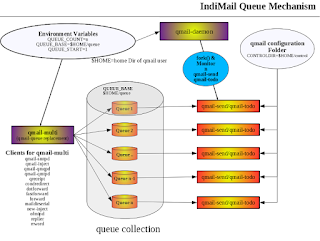A virtual domain is created by the command vadddomain(1).
% vadddomain example.com some_password
The above command creates a virtual domain with delivery instructions in /var/indimail/domains/example.com/.qmail-default file. A line in this file is of the form
/var/indimail/sbin/vdelivermail '' delivery_instruction_for_non_existing_user
The delivery_instruction_for_non_existing_user can have one of the following 5 forms
- delete
- bounce-no-mailbox
- Maildir
- emailAddress
- IPaddress
Using delete as the delivery instruction causes IndiMail to discard all mails addressed to non-existing users. The original sender does not get notified of the delivery. On a real messaging system serving real users, you will not want to do this.
The instruction bounce-no-mailbox causes a bounce to be generated to the sender in case an email is addressed to a non-existing user. This is the most common usage in .qmail-default which most IndiMail installations will have
The instruction Maildir causes emails to be addressed to non-existing users to be saved in a Maildir. Here Maildir should refer to a full path of an existing Maildir.
The instruction emailAddress causes emails to be addressed to non-existing users to be forwarded to an email address emailAddress.
The instruction IPaddress causes emails to be addressed to non-existing users to be redirected to a remote SMTP server at IP IPaddress. The format of IPaddress is domain:ip:port where domain is the domain name, ip is the IP address of the remote SMTP server and port is the SMTP port on the remote SMTP server. It is expected that the non-existing user is present on the remote system. This type of delivery is used by IndiMail on a clustered setup. In a clustered setup, users are distributed across multiple server. A particular user will be located only on one particular server. However, the same domain will be present on multiple servers.
In the delivery instruction in .qmail-default, you can replace vdelivermail with vfilter to perform in-line filtering use IndiMail's poweful vfilter. You can create filters using the program vcfilter.

1 comment:
Very informative... thanks...
Rk
Post a Comment